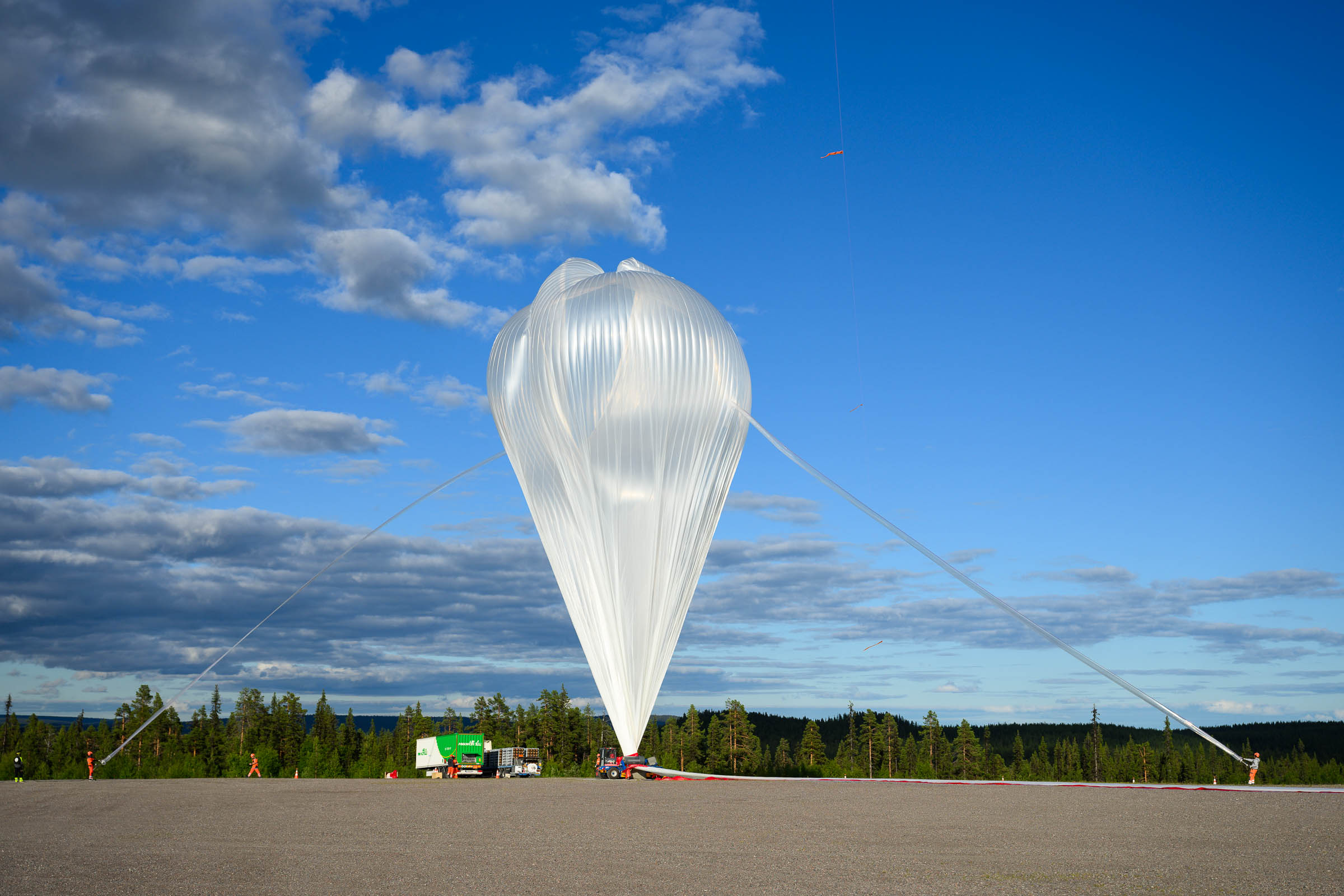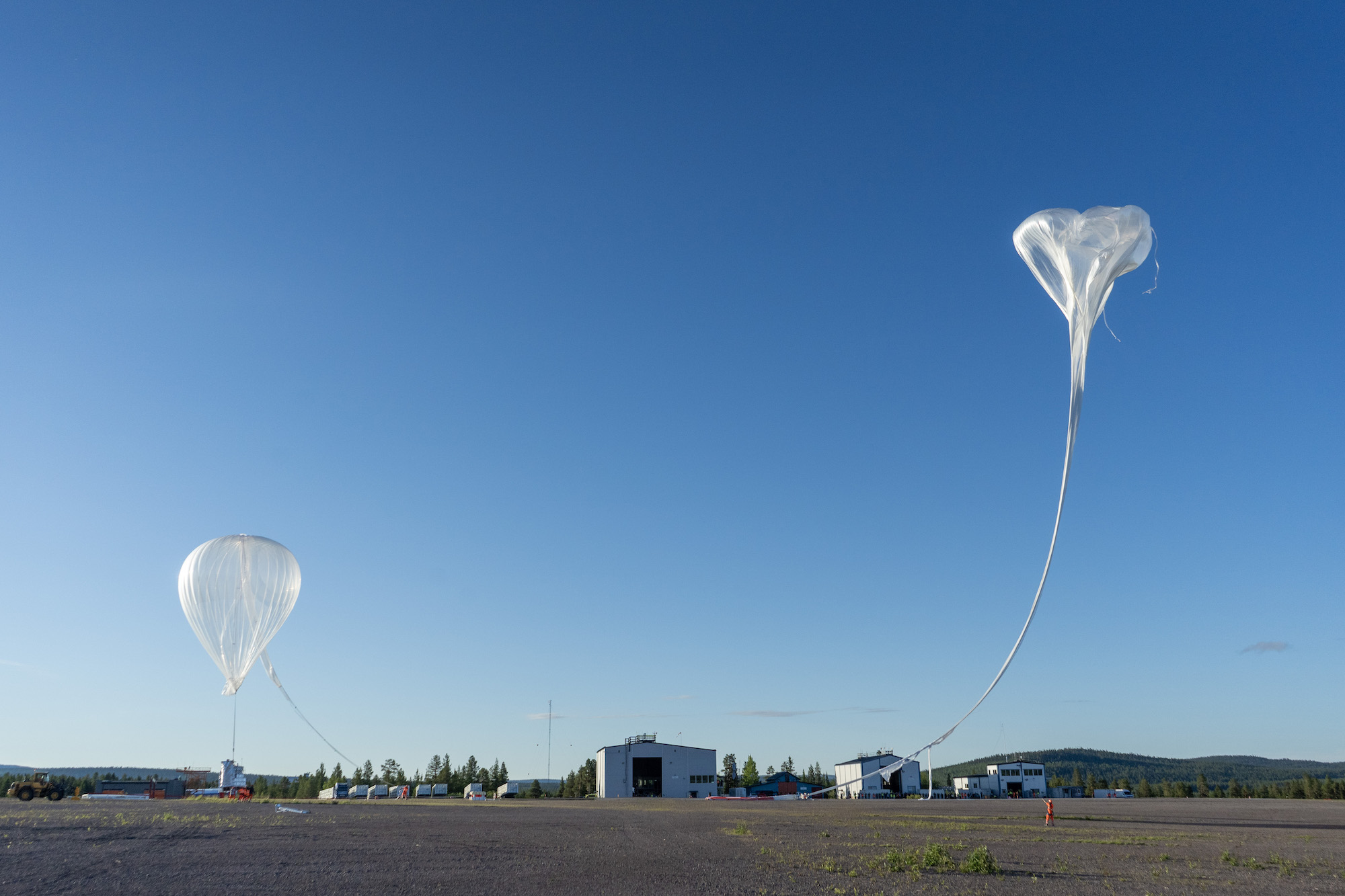Purpose of the flight and payload description
The TRANSAT mission was the first attempt by CNES to perform a long-duration transatlantic balloon flight from Sweden to Canada using a zero-pressure balloon. One of the main challenges of the mission was to closely follow the progress of the flight and interact with the scientific instruments on board, even over the ocean or in the regions out of range from the monitoring stations. To fill this lack of connection, CNES deployed a remote station at Kangerlussuaq on the west coast of Greenland and doubled its onboard-ground connections thanks to the addition of an Inmarsat satellite link to provide redundancy to the Iridium links already in use.
The scientific instruments were mounted on a CNES developed gondola denominated CARMEN composed of a structure made of steel struts and balls with dimensions of 2.45 m x 1.85 m x 3 m. Total mass of the gondola is 210 kg being capable of transporting several payloads up to a mass of 700 kg. For the TRANSAT mission the gondola counted with two independent pointing systems: one for the gondola itself and the other for the MEDOR system which provided electrical power. MEDOR is a retractable renewable energy system, solar generator developed by CNES, which was located below the gondola to power experiments during the long-duration balloon flight. It was installed on a horizontal axis of rotation in order to constantly point towards the Sun and provide the energy efficiency expected by scientific instruments, while limiting the number (and thus the weight) of on-board batteries.
At left we can see an scheme of distribution of the payloads in the gondola (click to enlarge). The experiments on board were:
Mini-SPECIES a lightened version of SPECIES (SPECtromètre Infrarouge à lasErs in Situ) a mid-infrared absorption spectrometer developed by the Laboratoire de Physique et Chimie de l'Environnement et de l'Espace (LPC2E) and the Laboratoire interdisciplinaire de Physique (LIPHY). It comprises two lasers coupled to two cavities and reduced electrical power, which allows its integration in aircraft or its operation for long-duration stratospheric balloon flights (> 4 days). High accuracies are obtained when calibration in flight, or at ground before and after the flight, is performed against standards. In addition to providing reference measurements for calibration/validation of space missions, these performances can lead to in-depth characterization of particular atmospheric processes.
CALASET (Canadian Atmospheric Laser Absorption Spectrometer Experiment Test-bed) a collaborative project between University of Toronto and University of Alberta to design laser spectrometers for stratospheric balloon flight. Instruments are constructed to be both highly sensitive and mechanically robust. It is composed by an infrared laser spectrometer built for in-situ sensing of CO2 and N2O on a stratospheric balloon gondola. Wavelength modulation spectroscopy (WMS) techniques are used to collect and visualize spectra during flight and to perform post-flight analysis.
GLORIA-lite (Gimballed Limb Observer for Radiance Imaging of the Atmosphere) a unique atmospheric remote sensing instrument that bridges the gap from scanning to imaging in the infrared spectral domain. This is realized by combining a classical Fourier transform spectrometer (FTS) with a 2-D detector array tailored to the FTS needs. Imaging allows the spatial sampling to be improved by up to an order of magnitude when compared to state of the art limb scanning instruments. In addition to the limb mode the instrument can also perform Nadir measurements. It was developed by the Karlsruhe Institute of Technology and the Research Centre Jülich from Germany.
OSIRIS (Optical Spectrograph and InfraRed Imager System) developed by the University of Saskatchewan is an optical spectrograph using a new optical design for potential use in a future micro-satellite mission that will measure high vertical resolution ozone profiles to improve forecasting.
A prototype of COMCUBE a space mission project, composed of several CubeSats, each containing a Compton telescope capable of measuring the polarization of gamma rays. It was developed by the Laboratoire de Physique des 2 infinis Irène Joliot-Curie of the Université Paris-Saclay.
NLC & IFS two experiments to study the noctilucent clouds and infrasounds in the stratosphere developed by the Swedish Institute of Space Physics in Kiruna
A GNSS receiver of new design
CERBUS an instrument for radiation test on substrates
Video resume of the mission
Details of the balloon flight

Balloon launched on: 6/22/2024 at 18:57 UTC
Launch site: European Space Range, Kiruna, Sweden
Balloon launched by: Centre National d'Etudes Spatiales (CNES)
Balloon manufacturer/size/composition: Zero Pressure Balloon model 803Z Hemeria 803.000 m3
End of flight (L for landing time, W for last contact, otherwise termination time): 6/26/2024
Balloon flight duration (F: time at float only, otherwise total flight time in d:days / h:hours or m:minutes - ): 3 d 19 h
Landing site: 77 nautic miles SE of Pond Inlet, Baffin Island, Canada
Campaign: TRANSAT 2024
External references
- CNES's first transatlantic balloon voyage starts at Esrange SSC website
- Four days in a balloon across the Arctic POLAR Journal
- Grande première pour le CNES : un ballon stratosphérique effectue un vol transatlantique La Tribune, France
- Historic giant balloon to be launched from Esrange SSC website
- Lancement de la campagne TRANSAT 2024 CNES website
- Mission accomplished for the TRANSAT 2024 campaign Canadian Space Agency website
- Stratospheric balloon travels from Sweden to Canada Meteorology Technology International
- Succès du vol du ballon Transat opéré par le CNES CNES press release
16581If you consider this website interesting or useful, you can help me to keep it up and running with a small donation to cover the operational costs. Just the equivalent of the price of a cup of coffee helps a lot.







